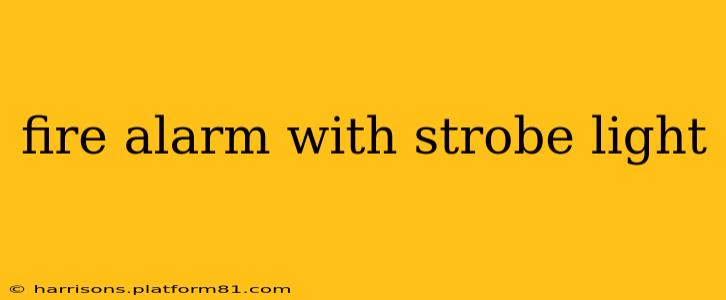Fire alarms save lives, and the addition of a strobe light significantly enhances their effectiveness, especially for individuals with hearing impairments. This comprehensive guide explores the vital role of strobe lights in fire alarm systems, addressing common questions and concerns. We'll delve into the technology, benefits, regulations, and considerations for choosing the right system for your needs.
What is a Fire Alarm with a Strobe Light?
A fire alarm with a strobe light combines the audible warning of a traditional smoke detector or heat detector with a visual alert. The strobe light, also known as a visual alarm, rapidly flashes, providing a clear signal of danger even if someone is unable to hear the alarm. This dual-warning system ensures that everyone in a building, regardless of their hearing abilities, receives timely notification of a fire.
How Does a Strobe Light Fire Alarm Work?
The strobe light in a fire alarm system is activated simultaneously with the audible alarm. When the smoke detector or heat sensor detects a fire, it triggers the alarm to sound and the strobe light to flash. These systems typically use LEDs for their bright, energy-efficient, and long-lasting light source. The flashing frequency and intensity often meet specific regulatory standards to ensure optimal visibility and impact. Most systems are interconnected, meaning a single alarm activation triggers all units in the system.
Why is a Strobe Light Important in Fire Alarms?
The addition of a strobe light to a fire alarm system is crucial for several reasons:
- Accessibility for the Hearing Impaired: Individuals who are deaf or hard of hearing rely on visual cues for safety alerts. A strobe light ensures they receive the same warning as those who can hear the alarm.
- Increased Awareness: Even those with normal hearing may not hear the alarm if they are asleep, using headphones, or in a noisy environment. The visual alert provides an additional layer of safety.
- Improved Response Time: The immediate visual warning can significantly reduce response time, allowing occupants to evacuate more quickly and safely.
- Compliance with Regulations: Many building codes and accessibility standards mandate the installation of visual fire alarms in specific locations and circumstances.
What are the Different Types of Strobe Lights Used in Fire Alarms?
Strobe lights used in fire alarms vary in features such as intensity, flash rate, and power source. They may be integrated directly into the smoke detector or heat detector housing, or installed as a separate, interconnected unit. Some high-intensity strobe lights are designed for large or high-noise environments, ensuring maximum visibility.
How Often Should Strobe Light Fire Alarms Be Tested?
Regular testing is critical to ensure the system’s functionality. Testing should be conducted monthly to check the functionality of both the audible and visual components. Annual professional inspections are also recommended to verify the system's overall performance and compliance with regulations.
Where Should Strobe Light Fire Alarms Be Installed?
Placement of fire alarms, particularly those with strobe lights, is crucial. They should be installed in strategic locations throughout the building, considering factors like potential fire origins, escape routes, and areas frequented by people with hearing impairments. Consult local building codes and fire safety regulations for specific requirements.
Are Strobe Light Fire Alarms Required by Law?
The legal requirements for strobe light fire alarms vary depending on location and building type. Many jurisdictions require their installation in certain settings, such as in residential buildings for the hearing impaired, or commercial buildings to meet accessibility standards like the Americans with Disabilities Act (ADA). Always consult local building codes and fire safety regulations to ensure compliance.
What are the Costs Associated with Installing Strobe Light Fire Alarms?
The cost of installing strobe light fire alarms depends on several factors, including the size of the building, the number of units required, and the type of system chosen. It is advisable to obtain quotes from several qualified installers to compare pricing and services.
Can I Install a Strobe Light Fire Alarm Myself?
While some simple systems may seem straightforward to install, it’s generally recommended to hire a qualified electrician or fire alarm technician for professional installation. Improper installation can compromise the system’s effectiveness and even create safety hazards. Professional installation guarantees compliance with local codes and ensures the system operates correctly.
By understanding the benefits and requirements of strobe light fire alarms, you can take crucial steps to enhance the safety and security of your home or business, protecting everyone within its walls. Remember, prioritizing safety is always the best investment.
